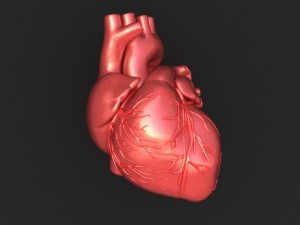Read this and know what your heart is doing everyday.

Following are the list of facts about our heart.
Every day, the heart creates enough energy to drive a truck 20 miles. In a lifetime, that is equivalent to driving to the moon and back.
The average adult heart beats 72 times a minute; 100,000 times a day; 3,600,000 times a year; and 2.5 billion times during a lifetime.
Though weighing only 11 ounces on average, a healthy heart pumps 2,000 gallons of blood through 60,000 miles of blood vessels each day.
The volume of blood pumped by the heart can vary over a wide range, from five to 30 liters per minute.
Because the heart has its own electrical impulse, it can continue to beat even when separated from the body, as long as it has an adequate supply of oxygen.
The fetal heart rate is approximately twice as fast as an adult’s, at about 150 beats per minute. By the time a fetus is 12 weeks old, its heart pumps an amazing 60 pints of blood a day.
The heart pumps blood to almost all of the body’s 75 trillion cells. Only the corneas receive no blood supply.
During an average lifetime, the heart will pump nearly 1.5 million gallons of blood—enough to fill 200 train tank cars.
Five percent of blood supplies the heart, 15-20% goes to the brain and central nervous system, and 22% goes to the kidneys.
The “thump-thump” of a heartbeat is the sound made by the four valves of the heart closing.
The heart does the most physical work of any muscle during a lifetime. The power output of the heart ranges from 1-5 watts. While the quadriceps can produce 100 watts for a few minutes, an output of one watt for 80 years is equal to 2.5 gigajoules.
The heart begins beating at four weeks after conception and does not stop until death.
A newborn baby has about one cup of blood in circulation. An adult human has about four to five quarts which the heart pumps to all the tissues and to and from the lungs in about one minute while beating 75 times.
The heart pumps oxygenated blood through the aorta (the largest artery) at about 1 mile (1.6 km) per hour. By the time blood reaches the capillaries, it is moving at around 43 inches (109 cm) per hour.
An anonymous contributor to the Hippocratic Collection (or Canon) believed vessel valves kept impurities out of the heart, since the intelligence of man was believed to lie in the left cavity.
Some heavy snorers may have a condition called obtrusive sleep apnea (OSA), which can negatively affect the heart.
Cocaine affects the heart’s electrical activity and causes spasm of the arteries, which can lead to a heart attack or stroke, even in healthy people.
A woman’s heart typically beats faster than a man’s. The heart of an average man beats approximately 70 times a minute, whereas the average woman has a heart rate of 78 per minute.
Blood is actually a tissue. When the body is at rest, it takes only six seconds for the blood to go from the heart to the lungs and back, only eight seconds for it to go the brain and back, and only 16 seconds for it to reach the toes and travel all the way back to the heart.
Grab a tennis ball and squeeze it tightly: that’s how hard the beating heart works to pump blood.
See how our heart works hardly to keep us alive. Say thanks to it.




